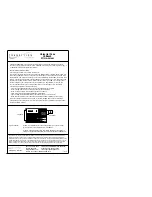
Board description
AN2451
38/55
Doc ID 12791 Rev 3
In any SMPS, protection against an output short
-
circuit is very important. All tests have been
done by shorting the SMPS output at maximum input voltage. The results are given in
.
The main parameters are the drain-source voltage (V
DS
), the output current (I
OUT
) and the
supply voltage (V
DD
).
The output current is an important parameter to be checked during shorts. Although the
output current peaks are quite high, the mean value is very low, thus preventing component
melting for excessive dissipation. In this way, the output rectifier, transformer windings and
PCB traces don't get overstressed. This assures system reliability against long-term shorts.
In case of device overheating, the integrated thermal protection stops the device operation
until the device temperature falls.
The startup phase could be critical for the SMPS. Output overshoot occurs if the circuit is
not properly designed. Care must be taken in designing a proper clamp network in order to
prevent voltage spikes, due to leakage inductance, from exceeding the breakdown voltage
of the device (730 V minimum value).
The startup transient is shown in
. It may be noted that the maximum drain-source
voltage doesn't exceed the minimum breakdown voltage BV
DSS
, with a reasonable safety
margin.
Finally, load regulation is presented in
, for different input voltages. With 230V
ac
,
the output voltage ranges from 12.3V to 11.1 V, within the requested tolerance.
Figure 33.
Typical waveforms at 230 V
ac
: open
load
Figure 34.
Typical waveforms at 230 V
ac
: full
load
Ch1 freq - 9.62 kHz (black)
Ch2 mean - 9.90 V (green)
I
OUT
V
DD
V
DS
Ch1 freq - 57.71 kHz (black)
Ch2 mean - 13.79 V (green)
Ch4 max - 503 mA (light blue)
V
DS
I
OUT
V
DD
















































